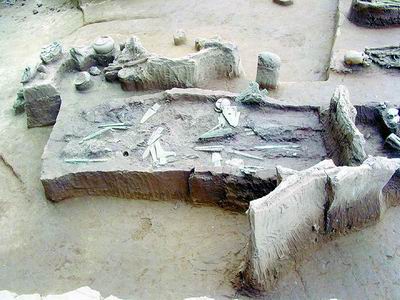Exploring Ba culture through Luojiaba site

A huge bronze cooking vessel unearthed from the M33 graveyard of the Luojiaba site
On Nov. 25 and 26, the “Luojiaba Site and Ba Culture Symposium,” co-sponsored by the Institute of Archeology at the Chinese Academy of Social Sciences (CASS) and the Sichuan Provincial Cultural Relics and Archeology Research Institute, was held in Xuanhan County, Sichuan Province. More than 100 archaeological and cultural experts from all over the country discussed the archaeological discovery and research of the Luojiaba site as well as the origins and evolution of Ba culture, a key part of the Bronze Age civilization in China’s southwestern and southern regions.
The Luojiaba site is located in the Jinhua village of Puguang town, Xuanhan County, Sichuan Province. Having a history of 3,000-5,300 years, it is one of the largest and well-preserved Ba cultural sites. Scholars believe that the site reflected the cultural exchanges and ethnic migration between the regions in the middle and upper reaches of the Yangtze River and the Central Plains.
Since 1999, the site has been excavated four times, revealing an area of 1,300 square meters, with more than 1,400 fragments of cultural relics unearthed, of which more than 200 were parts of rare cultural relics, such as bronze vessels, weapons, pottery and seals, unearthed at the M33 graveyard.
In the latest excavation, archaeologists excavated the areas keeping in mind existing gaps in knowledge, such as the unclear scope of the cemetery at the site and the unknown nature of Neolithic relics. They achieved great results by targeting the areas east of the previous excavation sites and the middle of the site.
Zheng Wanquan, a research fellow from the Sichuan Provincial Cultural Relics and Archeology Research Institute, who is responsible for the archaeological excavation, said the scope of the core area of the Ba Culture graveyard and the existence of ruins in the same period were confirmed. This provided new guidance for further excavation and site protection.
In terms of means of livelihoods, the site revealed agricultural crops, such as rice, millet and others, but in small amounts. Microliths of the early to the late period of Neolithic age were excavated. They achieved the same techniques and craftsmanship using local stone. Stone analysis shows that fishing, hunting and the acquisition economy were important means of livelihood to those who lived near the Luojiaba site.
Zheng added that the Neolithic relics excavated at the Luojiaba site are complete and show a clear sequence of evolution. Combined with other Neolithic sites in Guangyuan and Bazhong, they have gradually filled in gaps in the archeological cultural sequence in the northeastern Sichuan area of the middle and late Neolithic age, providing a new direction for exploring the evolutionary pattern of Neolithic culture in the upper reaches of the Yangtze River.
Chen Xingcan, director of the Institute of Archaeology at CASS, said the Luojiaba site provides an opportunity to explore the Jialing River basin during the Neolithic period. The ruins have a “clear stratigraphic basis.” Neolithic culture in this area resembled that of Hanzhong, Ankang in the middle and late Neolithic age, indicating that it related to the southward move of the culture in the west Han River and upstream of the Jialing River.
Li Shuicheng, a professor from the School of Archaeology and Museology at Peking University, argues that stoneware and pottery unearthed at the Luojiaba site provide important information to study the nature, age, sequence, origin, livelihood, industry and production of prehistoric cultures along the Jialing River. About 4,500 years ago, the remains of the site, represented by the fold deep-belly pots, connected the entire prehistoric cultures of the Jialing River basin. It reached the southern part of Shaanxi Province in the north, and reached southwards in Chongqing and the Three Gorges, or even to Northwest Hubei Province.
Gao Dalun, dean of the Sichuan Provincial Cultural Relics and Archeology Research Institute, said as the two kingdoms of Ba and Shu during the pre-Qin period of Sichuan Basin, the ancient Shu civilization had more archaeological discoveries and a clearer cultural outlook. In contrast, the Ba culture had remained undiscovered. The discovery of the Luojiaba site has given new hope to Ba culture researchers.
Wang Hui, director of the Institute of Cultural Relics and Archaeology in Gansu Province, said that Ba culture is a diverse, inclusive and compatible culture. The study of ornamentation of the artifacts unearthed at the Luojiaba site should be strengthened, some of which may be related to the remains of the Mesopotamia regions in West Asia.
Liu Guoxiang, a research fellow from the Institute of Archaeology at CASS, emphasized the value of the M33 graveyard at the Luojiaba site. He said that a few red agate beads had also been unearthed at M33. As agate beads are often placed together with ceremonial jade in tombs in the Central Plains, it is reasonable to speculate that ritual jade may be unearthed in this area in the future.

 PRINT
PRINT CLOSE
CLOSE